Harrogate: Difference between revisions
Created page with '{{Infobox town |name=Harrogate |county=Yorkshire |riding=West |picture=HarrogateCenotaph(DSPugh)Aug2005.jpg |picture caption=Harrogate |os grid ref=SE303550 |latitude=53.991 |lon…' |
|||
| Line 76: | Line 76: | ||
==Sights of the town== | ==Sights of the town== | ||
[[File:Cambridge Street, Harrogate.jpg|right|thumb|200px|Cambridge Street, Harrogate]] | [[File:Cambridge Street, Harrogate.jpg|right|thumb|200px|Cambridge Street, Harrogate]] | ||
[[File: | [[File:Betty's Tea Rooms, Harrogate DCP_1971.jpg|right|thumb|200px|Betty's Tea Rooms]] | ||
There are many fine examples of building and architecture about the town, including the Royal Hall theatre, a Grade II listed building designed by Frank Matcham.<ref>[http://www.royalhall.co.uk Royal Hall Theatre]</ref> As the only surviving Kursaal in Britain, the Royal Hall is an important national heritage building.<ref>[http://www.harrogate.co.uk/harrogate-band/hbhist5.htm Royal Hall history]</ref> Restoration work was completed in 2007, and the Hall was formally opened on 22 January 2008, by The Prince of Wales.<ref>{{cite news| url=http://news.bbc.co.uk/1/hi/england/north_yorkshire/7202162.stm | work=BBC News | title=Prince reopens saved Royal Hall | date=2008-01-22 | accessdate=2010-05-04}}</ref> | There are many fine examples of building and architecture about the town, including the Royal Hall theatre, a Grade II listed building designed by Frank Matcham.<ref>[http://www.royalhall.co.uk Royal Hall Theatre]</ref> As the only surviving Kursaal in Britain, the Royal Hall is an important national heritage building.<ref>[http://www.harrogate.co.uk/harrogate-band/hbhist5.htm Royal Hall history]</ref> Restoration work was completed in 2007, and the Hall was formally opened on 22 January 2008, by The Prince of Wales.<ref>{{cite news| url=http://news.bbc.co.uk/1/hi/england/north_yorkshire/7202162.stm | work=BBC News | title=Prince reopens saved Royal Hall | date=2008-01-22 | accessdate=2010-05-04}}</ref> | ||
Revision as of 16:23, 7 September 2014
| Harrogate | |
| Yorkshire West Riding | |
|---|---|
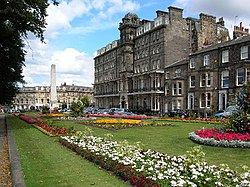 Harrogate | |
| Location | |
| Grid reference: | SE303550 |
| Location: | 53°59’28"N, 1°32’20"W |
| Data | |
| Population: | 71,594 (2001) |
| Post town: | Harrogate |
| Postcode: | HG1, HG2, HG3, HG5 |
| Dialling code: | 01423 |
| Local Government | |
| Council: | Harrogate |
| Parliamentary constituency: |
Harrogate and Knaresborough |
| Website: | http://www.harrogate.gov.uk/ |
Harrogate is a spa town in the West Riding of Yorkshire. The town is a tourist destination and its visitor attractions include its spa waters, RHS Harlow Carr gardens, and Bettys Tea Rooms. From the town one can explore the nearby Yorkshire Dales national park.
Harrogate originated in the 17th century, with the joining of two villages, High Harrogate and Low Harrogate. It lies adjacent to Knaresborough, with which it forms a single urban area, and is in the Nidd valley.
Harrogate grew from a village to a prosperous town on its spa water, which contains iron, sulphur and common salt. The town became known as 'The English Spa' in the Georgian Era, after its waters were first discovered in the 16th century. In the 17th and 18th centuries especially, these 'chalybeate' waters (which is to say they contain iron) were a popular health treatment, and the influx of wealthy but sickly visitors contributed significantly to the wealth of the town.
The town motto is Arx celebris fontibus, which means "a citadel famous for its springs."[1]
Geography
Harrogate is a commuter town for those working in the cities of Leeds and Bradford. It is a prosperous town and as such has some of the highest property prices in England, with many properties in the town and surrounding villages valued at £1 million or more.[2]
Harrogate stands at the edge of the Yorkshire Dales, with the Vale of York to the east and the upland Yorkshire Dales to the west and northwest. It has a dry and mild climate in the rain shadow of the Pennines. At an altitude of between 300 feet and 650 feet, Harrogate is higher than many English towns but it does not have the feel of a hillside town.
History
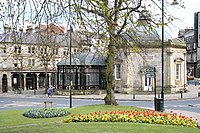
Before the discovery of water rich in iron and sulphur, Harrogate comprised two hamlets, High Harrogate and Low Harrogate, close to the historic town of Knaresborough. The first mineral spring was discovered in 1571 by William Slingsby, who found that water from the Tewit Well possessed similar properties to that from the springs of the Belgian town of Spa, which gave its name to all spa towns thereafter.
The medicinal properties of the waters were widely publicised by Edmund Deane, whose book, Spadacrene Anglica, or the English Spa Fountain was published in 1626. Harrogate developed fame as a spa town following the enclosure of surrounding lands in 1770, when 200 acres were reserved as public commons, the Stray, which has remained a popular spot for picnicking, kite-flying, outdoor games and local football matches.[3] To provide entertainment for increasing numbers of visitors to the village, the Georgian Theatre was built in 1788. Bath Hospital (later the Royal Bath Hospital) was built in 1826. The Royal Pump Room was built in 1842.
In 1870, engineering inventor Samson Fox perfected the process of creating water gas, in the basement laboratory of Grove House. After constructing a trial plant at his home on Scarborough Road, making it the first house in Yorkshire to have gas lighting and gas heating; he built a town-sized plant to supply Harrogate. After he had completed the conversion of Parliament Street to make it the world's first route to be lit by water-gas, newspapers commented: "Samson Fox has captured the sunlight for Harrogate." After donating the town's first fire engine, and building the towns theatre, he was later elected mayor for three years, a still unbroken record.
Today the site of the Tewit Well is marked by a dome on the Stray. Other wells can be found in Harrogate's Valley Gardens and the Royal Pump Room museum.
During the late 19th and early 20th centuries, Harrogate was popular among the English élite and was frequented by nobility from mainland Europe. Its popularity declined after First World War. During Second World War, Harrogate's large hotels accommodated government offices that had been evacuated from London. This paved the way for the town's current function as a commercial, conference, and exhibition centre.
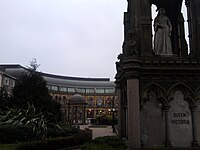
In 1893 Harrogate doctor George Oliver was the first to observe the effect of adrenaline on the circulation.
Former employers in the town were ICI, who occupied offices and laboratories at Hornbeam Park, the Central Electricity Generating Board, and the Milk Marketing Board. ICI's laboratories at Hornbeam Park were the location of the invention of Crimplene in the 1950s, named after the nearby Crimple Valley and Beck.
Harrogate won the 2003 Britain in Bloom in the category of "Large Town" and won the European Entente Florale competition in 2004. This reprises its win in the first Entente Florale competition in 1977. Harrogate was a gold medal winner of Europe in Bloom in 2004. In 2005, a Channel 4 TV show listed Harrogate as the UK's third best place to live. In 2006 it came fourth in the same league; the programme claimed that it placed lower due to "a slight dip in exam results", though presenter Phil Spencer noted that it was his personal favourite.[4]
In 2007, two metal detectorists found the Harrogate hoard, a 10th century Viking treasure hoard, near Harrogate. The hoard contains almost 700 coins and other items from as far away as Afghanistan. The hoard was described by the British Museum as the most important find of its type in Britain for 150 years.[5]
Economy
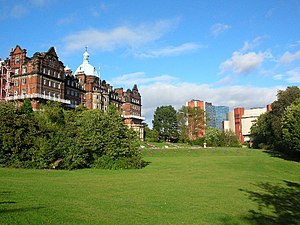
Harrogate has a strong and varied economy. The conference and exhibition industry is the focus of the town's business, with Harrogate International Centre[6] being the third largest fully integrated conference and exhibition centre in the United Kingdom, and one of the largest in Europe. It brings in over £150 million to the local economy every year and attracts in excess of 350,000 business visitors annually.[7]
Also in and about Harrogate are the Great Yorkshire Showground and Pavilions of Harrogate, which are major conference destinations.
The Great Yorkshire Showground is the hub of the regional agricultural industry, hosted by the Yorkshire Agricultural Society. The Great Yorkshire Show takes place here each year.
The many business visitors to Harrogate sustain a number of large hotels, originally built for visitors to the Spa.
Harrogate's main shopping district is focused on Cambridge Street, Oxford Street, Beulah Street and James Street where most of the high street shops can be found. There is a wide range of boutique and designer shopping on Parliament Street and in the Montpellier Quarter, as well as independent shopping around Commercial Street.
Eating out is popular in Harrogate, with the town well served by restaurants. Parliament Street and Cheltenham Parade are lined with many independent and chain restaurants, while there is also a concentration of chain restaurants on John Street and Albert Street.
Continuing Harrogate's tradition as a place of health and well being, there is a public Turkish bath on Parliament Street. The Turkish bath has a steam room, tepidarium, calidarium, laconium, plunge pool and a relaxation room, and offers spa treatments.[8]
Sights of the town
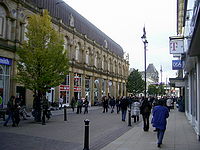
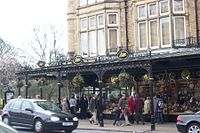
There are many fine examples of building and architecture about the town, including the Royal Hall theatre, a Grade II listed building designed by Frank Matcham.[9] As the only surviving Kursaal in Britain, the Royal Hall is an important national heritage building.[10] Restoration work was completed in 2007, and the Hall was formally opened on 22 January 2008, by The Prince of Wales.[11]
The Royal Pump Room houses Europe's strongest sulphur well,[12] but is now a museum showcasing the town's spa history.
Two military installations are both located to the immediate west of Harrogate, the Army Foundation College and RAF Menwith Hill, an electronic monitoring station.
Montpellier Quarter
Bettys Tea Rooms are regionally renowned. They are owned by Bettys and Taylors of Harrogate - the same company that makes the nationally well-known Yorkshire Tea. Bettys has a second tea room at the RHS Harlow Carr Gardens.[13]
The Mercer Art Gallery[14] is home to Harrogate district's fine art collection which consists of some 2,000 works of art, mainly from the 19th and 20th centuries. The collection includes works by William Powell Frith, Atkinson Grimshaw, Sir Edward Burne-Jones, Dame Laura Knight, Alan Davie and many more.
The Montpellier Quarter is also the centre of the town's nightlife, which is mainly centred on the renovated Royal Baths development.
Hollins Hall
Hollins Hall is a small retirement village on the outskirts of the Yorkshire Dales, set in 14 acres of garden landscape. The village is rich in history with Georgian manor houses which were once occupied by the famous Tetley family.[15]
Hollins Hall has become the centre of an ever growing community, very close to Harrogate town centre.
Parks and gardens
The Valley Gardens, in Low Harrogate, is the town's main park and covers much of the area originally known as 'Bogs Field', where a number of springs were discovered. Valley Gardens has a number of attractions including an ice cream parlour and a children's play area with an outdoor paddling pool. The Sun Pavilion at the northern edge of the park can be privately hired for events such as wedding receptions. A pitch and putt golf course, crazy golf, tennis courts and bowling green are in the west of the park. The Friends Of Valley Gardens group was formed in 2009 to support the park. FOVG works in partnership with Harrogate Borough Council to guide the Park's future use and development.
The Stray is an area of open parkland of some 200 acres in the centre of the town. It was created in 1778 to link together most of Harrogate's springs in one protected area by an Act of Parliament which fixed its area as 200 acres, and even now when part of it is removed, for example due to road widening, it must be replaced elsewhere. During the Victorian period, there was a racecourse for horses in the Stray. There is a funfair twice each summer which attracts tourists.
RHS Harlow Carr gardens is a privately-owned group of award-winning themed gardens on the outskirts of Harrogate.
Crescent Gardens is a small open area in central Harrogate. It is surrounded by some of the town's main tourist attractions including the Royal Pump Room, Royal Baths and Royal Hall, as well as the Town Hall. Hall M of the Harrogate International Centre also fronts onto Crescent Gardens.
The town has several smaller parks and gardens, including Jubilee Gardens and Victoria Gardens on the eastern side of central Harrogate.
Sport
- Cricket:
- Bilton Cricket Club
- Harrogate Cricket Club with Bilton defeating Harrogate in their last clash at St Georges Road in the Black Sheep Trophy in 2006.
- Harrogate Cricket Club
- Yorkshire Women cricket team
- Football:
- Harrogate Town FC
- Harrogate Railway Athletic FC
- Rugby Union: Harrogate RUFC
- Swimming: Harrogate District Swimming Club
- Running:
- Rock climbing: at Almscliffe Crag and Brimham Rocks
Outside links
| ("Wikimedia Commons" has material about Harrogate) |
- Historical interest:
- Project Gutenberg etext of Edmund Deane's Spadacrene Anglica
- Harrogate People, Places, Events, Historical Brochures, etc.
- Bilton Historical Society
- Media:
- Harrogate Advertiser - local newspaper
- Harrogate Confidential.com - local online magazine
- Harrogate-News - local online news
- Sport:
- Harrogate Theatre
- For visitors:
- gardensharrogate.co.uk: parks & gardens to visit in the Harrogate area
- Miscellaneous:
References
- ↑ M2 (2003-12-09). "Harrogate". Bottled Water of the World. http://www.finewaters.com/Water_Spas/British_Spa_Towns/Harrogate.asp. Retrieved 2008-12-26.
- ↑ "The most expensive streets in Yorkshire and the Humber 2008". The Times (London). 2008-02-19. http://property.timesonline.co.uk/tol/life_and_style/property/article3393083.ece. Retrieved 2010-05-04.
- ↑ Harrogate Borough Council: the Stray
- ↑ Channel 4 Best & Worst
- ↑ "Viking treasure hoard uncovered". BBC News. 2007-07-19. http://news.bbc.co.uk/2/hi/uk_news/england/north_yorkshire/6906107.stm. Retrieved 2007-07-19.
- ↑ [1]
- ↑ What HIC means to Harrogate Harrogate International Centre
- ↑ "Harrogate Tourist Information". Hello Yorkshire. http://www.hello-yorkshire.co.uk/harrogate/tourist-information. Retrieved 2010-02-19.
- ↑ Royal Hall Theatre
- ↑ Royal Hall history
- ↑ "Prince reopens saved Royal Hall". BBC News. 2008-01-22. http://news.bbc.co.uk/1/hi/england/north_yorkshire/7202162.stm. Retrieved 2010-05-04.
- ↑ Royal Pump Room Museum
- ↑ Betty's Tea Rooms
- ↑ Mercer Art Gallery
- ↑ Hollins Hall Retirement Village
